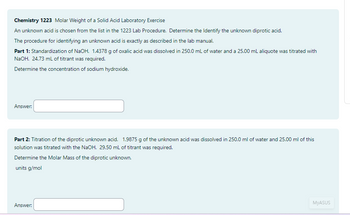
Chemistry
10th Edition
ISBN: 9781305957404
Author: Steven S. Zumdahl, Susan A. Zumdahl, Donald J. DeCoste
Publisher: Cengage Learning
expand_more
expand_more
format_list_bulleted
Question

Transcribed Image Text:Chemistry 1223 Molar Weight of a Solid Acid Laboratory Exercise
An unknown acid is chosen from the list in the 1223 Lab Procedure. Determine the Identify the unknown diprotic acid.
The procedure for identifying an unknown acid is exactly as described in the lab manual.
Part 1: Standardization of NaOH. 1.4378 g of oxalic acid was dissolved in 250.0 mL of water and a 25.00 mL aliquote was titrated with
NaOH. 24.73 mL of titrant was required.
Determine the concentration of sodium hydroxide.
Answer:
Part 2: Titration of the diprotic unknown acid. 1.9875 g of the unknown acid was dissolved in 250.0 ml of water and 25.00 ml of this
solution was titrated with the NaOH. 29.50 mL of titrant was required.
Determine the Molar Mass of the diprotic unknown.
units g/mol
Answer:
MyASUS
SAVE
AI-Generated Solution
info
AI-generated content may present inaccurate or offensive content that does not represent bartleby’s views.
Unlock instant AI solutions
Tap the button
to generate a solution
to generate a solution
Click the button to generate
a solution
a solution
Knowledge Booster
Similar questions
- A strong acid-strong base titration was performed as follows: 10.00 mL of 0.10M HCl were collected in an Erlenmeyer flask, and then diluted to 100 mL with distilled water. After that, two drops of indicator were added. Then, the buret was filled with 0.100 M NaOH. The titration was started by slowly adding NaOH to HCl. (Note: The volume of two drops indicator is ignored as it is so tiny compared with 100 mL.) What is the pH of the solution in the Erlenmeyer flask after adding 10.20 ml of 0.100M NaOH? Select one:a. 9.80b. 10.26c. 9.90d. 11.08arrow_forwardYou set up a titration in the lab to determine the concentration of an HCl solution. What is the molarity of an HCl solution if 0.0100 L of 0.245 M NaOH soln’ are required to neutralize 0.0150 L HCl? 2.25 M 0.163 M 1.34 M 0.245 Marrow_forwardA 25.00 mL sample of magnesium hydroxide solution is titrated with 0.00500 M HCl and 2 drops of methyl orange indicator. The endpoint of the titration is reached when 14.65 mL of HCI has been added. How many moles of hydroxide are present in the sample? O A. 1.25 x 10^-4 moles O B. 6.60 x 10^-5 O C. 2.64 x 10^-5 O D. 7.33 x 10^-5 molesarrow_forward
- A 1.0 M solution of HNO3 was used to neutralize 100.0 ml of 0.20 M Ba(OH)2. b. How many ml of 1.0 M HNO3 are needed to neutralize 100.0 ml of 0.20 M Ba(OH)2?arrow_forwardI dont know how to do this question.arrow_forwardHow many mL of 1.0 M HCl will be needed to react with 5.0 mL of 2.0 M Ca(OH)2?arrow_forward
- Question 6arrow_forwardD * Question Completion Status: Moving to the next question prevents changes to this answer. Question 1 D 5 points What is the percent of CaCO3 in an antacid given that a tablet that weighed 1.3198 g reacted with 50.00 mL of 0.4486 N HCI that subsequently required 3.72 mL of 0.1277 N NaOH for back titration? NB. Write the only value without units, eg: If the correct answer is 5.5%, write 5.5. A Moving to the next question prevents changes to this answer. MECER 6 Question 1 of 27 ENG US Save Answer Question 1 of 27 > 14:29 2022/10/05arrow_forward15. A NAOH(aq) solution and an acid-base indicator are used to determine the molarity of an HCI(ag) olution. A 25.0-milliliter sample of the HCI(aq) is exactly neutralized by 15.0 milliliters of 0.20M laOH(aq). Identify the laboratory process described in this passage.arrow_forward
- An analytical chemist weighs out 0.318 g of an unknown triprotic acid into a 250 mL volumetric flask and dilutes to the mark with distilled water. He then titrates this solution with 0.0600 M NaOH solution. When the titration reaches the equivalence point, the chemist finds he has added 82.8 mL of NaOH solution. Calculate the molar mass of the unknown acid. Be sure your answer has the correct number of significant digits. mol x10 x 3arrow_forwardA 100 mL sample of HCI was titrated with KOH. If 29.5 mL of the 2.75 M KOH solution was required to neutralize the acid, what is the molarity of the HCl solution?arrow_forwardWhat’s the answer in Marrow_forward
arrow_back_ios
SEE MORE QUESTIONS
arrow_forward_ios
Recommended textbooks for you
 ChemistryChemistryISBN:9781305957404Author:Steven S. Zumdahl, Susan A. Zumdahl, Donald J. DeCostePublisher:Cengage Learning
ChemistryChemistryISBN:9781305957404Author:Steven S. Zumdahl, Susan A. Zumdahl, Donald J. DeCostePublisher:Cengage Learning ChemistryChemistryISBN:9781259911156Author:Raymond Chang Dr., Jason Overby ProfessorPublisher:McGraw-Hill Education
ChemistryChemistryISBN:9781259911156Author:Raymond Chang Dr., Jason Overby ProfessorPublisher:McGraw-Hill Education Principles of Instrumental AnalysisChemistryISBN:9781305577213Author:Douglas A. Skoog, F. James Holler, Stanley R. CrouchPublisher:Cengage Learning
Principles of Instrumental AnalysisChemistryISBN:9781305577213Author:Douglas A. Skoog, F. James Holler, Stanley R. CrouchPublisher:Cengage Learning Organic ChemistryChemistryISBN:9780078021558Author:Janice Gorzynski Smith Dr.Publisher:McGraw-Hill Education
Organic ChemistryChemistryISBN:9780078021558Author:Janice Gorzynski Smith Dr.Publisher:McGraw-Hill Education Chemistry: Principles and ReactionsChemistryISBN:9781305079373Author:William L. Masterton, Cecile N. HurleyPublisher:Cengage Learning
Chemistry: Principles and ReactionsChemistryISBN:9781305079373Author:William L. Masterton, Cecile N. HurleyPublisher:Cengage Learning Elementary Principles of Chemical Processes, Bind...ChemistryISBN:9781118431221Author:Richard M. Felder, Ronald W. Rousseau, Lisa G. BullardPublisher:WILEY
Elementary Principles of Chemical Processes, Bind...ChemistryISBN:9781118431221Author:Richard M. Felder, Ronald W. Rousseau, Lisa G. BullardPublisher:WILEY

Chemistry
Chemistry
ISBN:9781305957404
Author:Steven S. Zumdahl, Susan A. Zumdahl, Donald J. DeCoste
Publisher:Cengage Learning

Chemistry
Chemistry
ISBN:9781259911156
Author:Raymond Chang Dr., Jason Overby Professor
Publisher:McGraw-Hill Education

Principles of Instrumental Analysis
Chemistry
ISBN:9781305577213
Author:Douglas A. Skoog, F. James Holler, Stanley R. Crouch
Publisher:Cengage Learning

Organic Chemistry
Chemistry
ISBN:9780078021558
Author:Janice Gorzynski Smith Dr.
Publisher:McGraw-Hill Education

Chemistry: Principles and Reactions
Chemistry
ISBN:9781305079373
Author:William L. Masterton, Cecile N. Hurley
Publisher:Cengage Learning

Elementary Principles of Chemical Processes, Bind...
Chemistry
ISBN:9781118431221
Author:Richard M. Felder, Ronald W. Rousseau, Lisa G. Bullard
Publisher:WILEY